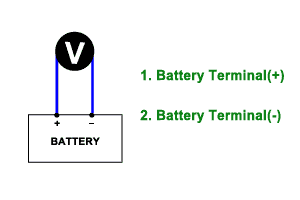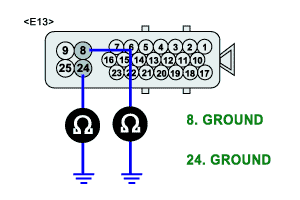Has a problem been found?
YES
Repair as necessary and then go to "Verification of Vehicle Repair" procedure.
NO
Go to "Alternator Output Voltage Inspection" procedure.
Many malfunctions in the electrical system are caused by poor harness(es) and terminals. Faults can also be caused by interference from other electrical systems, and mechanical or chemical damage.
Thoroughly check connectors for looseness, poor connection, bending, corrosion, contamination, deterioration, or damage.
Has a problem been found?
YES
Repair as necessary and then go to "Verification of Vehicle Repair" procedure.
NO
Go to "Alternator Output Voltage Inspection" procedure.
Engine "ON".
Measure voltage between the battery terminal(+) and the battery terminal(-).
Specification : Approx. 14±0.6V (140℉)

Volage Regulator Ambinent Temperature ℃(℉) | Regulating Voltage |
-20(-4) | 14.2 - 15.4 |
20(68) | 13.9 - 14.9 |
60(140) | 13.4 - 14.6 |
80(176) | 13.1 - 14.5 |
Is the measured voltage within specifications?
YES
Go to "Power Circuit Inspection" procedure.
NO
Check for the damaged harness and poor connection between alternator and battery. If OK repair or replace alternator and then go to "Verification of Vehicle Repair" procedure.
Engine "ON".
Measure voltage between the battery terminal(+) and terminal "4" of the HECU harness connector.
Specification : Approx. below 0.2V

Is the measured voltage within specifications?
YES
Go to "Ground Circuit Inspection" procedure.
NO
Check for damaged harness and poor connection between the battery terminal(+) and terminal "4" of the HECU harness connector. Repair as necessary and then go to "Verification of Vehicle Repair" procedure.
Ignition "OFF".
Disconnect HECU connector.
Measure resistance between terminal "8,24" of the HECU harness connector and chassis ground.
Specification : Approx. below 1Ω

Is the measured resistance within specifications?
YES
Go to "Component Inspection" procedure.
NO
Check for damaged harness and poor connection between terminal "8,24" of the HECU harness connector and chassis ground. Repair as necessary and then go to "Verification of Vehicle Repair" procedure.